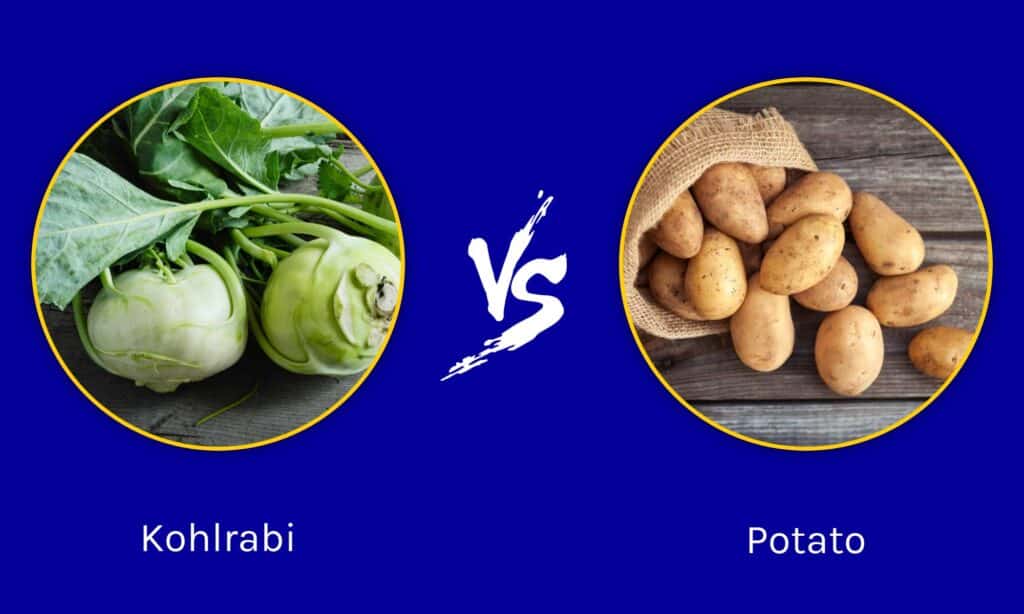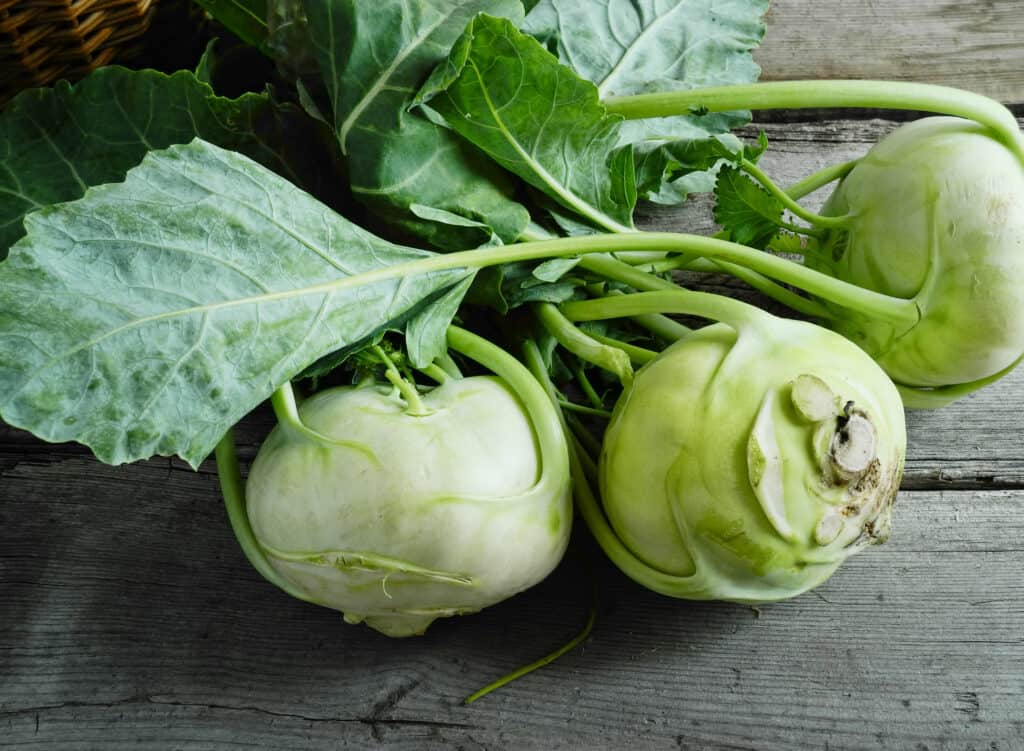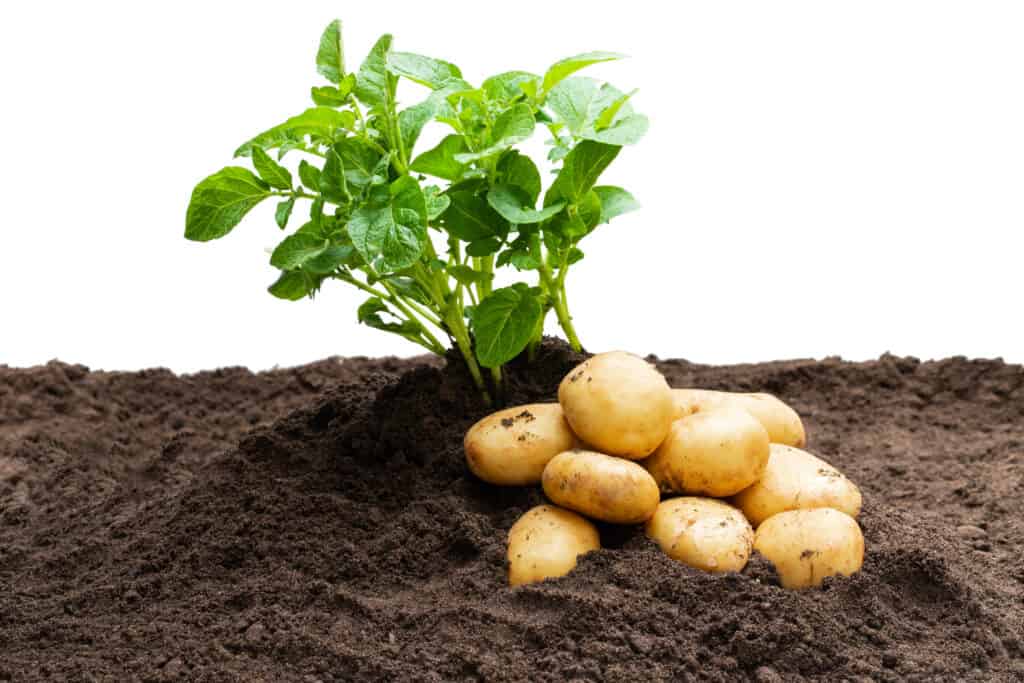When researching cold-hardy, resilient vegetable crops, kohlrabis, and potatoes are two leading contenders. While these plants have similar growth needs and versatility, they’re two different vegetables. So, kohlrabi vs. potato: here’s everything you need to know about their similarities and differences and why both are great crops.

Comparing Kohlrabi vs. Potato
| Kohlrabi | Potato | |
|---|---|---|
| Classification | Brassica oleracea var. gongylodes | Solanum tuberosum |
| Alternative Names | Turnip cabbage, wild cabbage, German turnip | Tuber, tater, spud |
| Origin | Europe | North America, South America |
| Description | The edible root is bulbous, growing up to 6 inches in diameter with a waxy, light green, or purple color. Frilly, green leaves grow upward from the bulb, reaching up to 18 inches tall and 24 inches wide. | Tuber varieties grow in shades of brown, purple, red, and yellow, ranging in size based on variety. Green stems and robust foliage grow up to 3 feet tall with a proportionate span. |
| Uses | This versatile vegetable is used for culinary purposes. It can be roasted, added to soups, and used for salads. | Potatoes are high in nutrient value, with over 4000 domesticated varieties and 180 wild varieties. |
| Growth Tips | Plant in loamy soil in USDA Zones 2-11 in early spring in full sun. This cold-resistant vegetable will endure late-season frosts. Leave ample room for growth, spacing seedlings as they grow. Water weekly and fertilize regularly. Harvest when bulbs reach 4-6 inches in diameter. | Plant potato cuttings cut-side down in USDA Zones 3-10 after the risk of frost has passed in full sun. Leave ample room for growth. Water weekly and fertilize regularly. Harvest when blossoms are in full bloom for new potatoes, or wait 3-4 months for fully developed potatoes. |
| Interesting Features | Kohlrabi is high in nutrient value, resistant, and easy to grow, making it an ideal vegetable for gardeners of all levels. | Potatoes are high in nutrient value with over 4000 domesticated varieties and 180 wild varieties. |
| Flavor Profile | Peppery, sweet, crunchy, earthy | Mild, earthy, sweet |
The Key Differences Between Kohlrabi and Potato
While you can find both kohlrabi and potatoes growing underground or stored safely away in root cellars, they’re unrelated. People often describe kohlrabi as a mix of cabbage and turnip, even though it isn’t a root vegetable. It has a crunchiness akin to cabbage or broccoli stems.
On the other hand, potatoes stand out as one of the most adaptable vegetables worldwide. Unlike kohlrabi, which belongs to the cabbage family, potatoes classify as tubers, a kind of root vegetable. Raw potatoes have a hard, crunchy texture but become soft, creamy, and fluffy once cooked.
Another key difference between kohlrabi and potato is their point of origin. Potatoes are one of the oldest-known vegetables in the Americas, whereas Kohlrabi is European.
Kohlrabi vs. Potato: Classification
Kohlrabi is classified as Brassica oleracea, the same species as cabbage, broccoli, and other cruciferous vegetables. The differentiation is in the variety, gongylodes, which translates to “roundish.”
Potato is classified as Solanum tuberosum, a tuber in the nightshade family, which it shares with tomatoes and eggplants. There are thousands of potato cultivars.

The kohlrabi belongs to the cabbage family.
©Haskounek/Shutterstock.com
Kohlrabi vs. Potato: Origin
Potatoes originated in the Americas, ranging from Canada down to Peru. Indigenous people in the Andean region of South America domesticated potatoes long before Europeans colonized the area. Records of domesticated potatoes date back as far as 10,000 BCE as a preferred crop for the Inca people of Peru and Bolivia.
Kohlrabi is a European vegetable. The earliest records show that Northern Europeans cultivated kohlrabi in the 1500s. The name comes from the German words “Kohl,” which means “cabbage,” and “Rabi,” which means “turnip.” Kohlrabi’s shape resembles a turnip, but its color and texture mirror that of a cabbage, hence the fitting name “turnip cabbage.”

The origin of potatoes has been traced down to the Americas.
©Val_R/Shutterstock.com
Kohlrabi vs. Potato: Description
The kohlrabi vegetable is round and similar in shape to a turnip. It grows up to 6 inches in diameter with a waxy, light green, or purple color. Both the light green (often called “white”) and purple varieties have a light green interior. The leaves grow directly from the bulb, reaching up to 18 inches tall and 24 inches wide, with white blossoms at peak season.
Potato plants share similar features, growing up to three feet tall with a proportionate span and robust, leafy foliage. The plants bloom in white, purple, and yellow shades when the tubers are ready to harvest.
The taste and texture of Kohlrabi are similar to cabbage, though milder, with a higher ratio of edible root to leaves.
Potatoes are tough, juicy, and crunchy when raw, becoming soft, creamy, and fluffy when baked, boiled, or mashed. There are differences in texture and presentation based on variety and cooking styles.
Kohlrabi vs. Potato: Uses
People have relied on kohlrabi and potatoes for nourishment for centuries. Their simple growth requirements and rich nutrient content classify them as ideal crops.
Thanks to its crunchy texture and appearance, chefs often incorporate kohlrabi into slaws and salads. They also sauté, add it to soups, or roast it for side dishes.
Potatoes are incredibly versatile, with presentations ranging from mashed potatoes to French fries. There are hundreds of ways to prepare potatoes as an ingredient or a side.
Kohlrabi vs. Potato: Growth Tips
Potatoes grow from cuttings rather than seeds. Plant potato cuttings with eyes (sprouts) facing up and cut-side facing down after the risk of frost has passed. Like kohlrabi, potatoes are resilient plants and thrive in USDA Zones 3-10. Plant in full sun and water frequently. Harvest early while flowers are blooming for new potatoes with thin peels or after the blooms have faded for fully mature tubers.
Kohlrabi is a cold-resistant vegetable with a significant geographic hardiness range (USDA Zones 2-11). Plant seeds directly in the soil after the ground thaws — no need to wait for the risk of frost to pass. Plant in an area that gets full sun. Space seedlings as they grow to provide ample room for growth, ideally 12 inches between plants. Assessing the size of the kohlrabi is the best way to determine readiness. Store in a root cellar or dark, dry cabinet until use.

Potatoes are resilient plants.
©Elena Zajchikova/Shutterstock.com
The photo featured at the top of this post is © iStock.com/MahirAtes
Thank you for reading! Have some feedback for us? Contact the AZ Animals editorial team.






